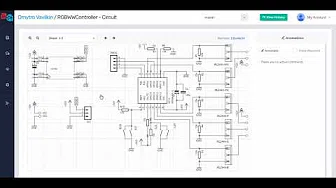Files
LS Rect Diode.mdSynchronous Rectification DC-DC Converters
MOSBD (MOSFET with SBD)
https://mm.digikey.com/Volume0/opasdata/d220001/medias/docus/379/Mosfets...
- wire inductance is problabmatic
- there are MOSBD: mosfets with built-in schottky diode
- https://eepower.com/new-industry-products/toshiba-announces-five-new-30v...
mosbd (aka FETKEYs)
- todo do they still exist?
- https://electronics.stackexchange.com/questions/722022/what-happened-to-...
https://www.ti.com/lit/wp/snva595a/snva595a.pdf
choosing: https://www.ti.com/lit/an/slyt358/slyt358.pdf?ts=1723233149127 https://electronics.stackexchange.com/questions/676063/reverse-recovery-...
Increasing sync buck efficiency with a diode
A Schottky diode in parallel to the LS switch can increase power conversion efficiency of the buck converter:
- A Schottky diode with lower forward voltage than the MOSFETs body diode will decrease losses during dead-time.
- Potential decrease or complete elimination of reverse recovery losses if the. Schottky have neglitable turn-on losses
A diode can incorporate additional losses to the system:
- For PN-Diodes, during HS turn-on (diode turn-off), the reverse voltage can cause reverse recovery. Schottky diodes do not suffer from this. ( see Losses in Power Diodes.)
- parasitic junction capacitance (see below)
- parasitic inductances between external diode and mosfet can cause mosfet self turn-on and additional conduction loss ( see Toshiba Mosfet Product Guide 2009)
For lowest losses in a sync buck, the diode should then have these characteristics:
- Schottky barrier diodes (no PN reverse recovery)
- Low forward-voltage to prevent MOSFET body diode turn on (MOSFET reverse recovery)
- Lower forward-voltage than MOSFET to reduce conduction loss during dead-time
- small lead inductance, SMD
Schottky diodes can have a significant junction capacitance, which looks similar to the reverse recovery effect of the body diode, but at a smaller magnitude (https://ez.analog.com/ez-blogs/b/engineerzone-spotlight/posts/how-a-smal...)
CSD19506KCS and ST40100C
Here's a V-I-plot of the CSD19506KCS mosfet body diode and ST40100C overlay:
^ Diode forward voltage of CSD19506KCS and ST40100C in an overlay-plot. At 25°C ST40100C's fwd voltage is lower up to to ~28A. At 125°C the curves cross at ~15A.
Diode Selection
https://www.digikey.de/short/382502p8
| Vpeak | Iav | Ipr | Vf_typ @25°15A | Vf_max_125 | Ct_typ(5V) | |||
|---|---|---|---|---|---|---|---|---|
| ST40100C | 100V | 2*20A | 0.65 | 0.7 | 845pF *2 | |||
| ST10100S | 100V | 15A | 0.68 | |||||
| ST20100S | 100V | 20A | 0.67 | |||||
| ST15100S | TO-277B | 100V | 0.68 | |||||
| ST3050DJF | ||||||||
| MBR30200CT (smc) | 200V | 2*15A | 20A*2 | 0.85 (0.9 max) | 0.75 | 200pF *2 (400pf max) | ||
| STPS60170C | 170V | 2*30A | 0.94 (max) | 0.76 | 1200pF *2 | https://www.st.com/resource/en/datasheet/stps60170c.pdf | ||
| mcc MBR20200CT | 200V | 2* | ||||||
| mbr30200ct (diotec) | 200V | 0.97 | 700pF *2 | https://diotec.com/request/datasheet/mbr30100ct.pdf | ||||
| mbr30150ct (diotec) | 0.85 | 700pF *2 | ||||||
| UF160FCT (panjit) | 200V | 1.0 | 170pF *2 | trr=50ns https://www.panjit.com.tw/upload/datasheet/UF1600FCT_SERIES.pdf | ||||
| MBRD20200CT (smc) | 200V | 2*10A | 0.95 | |||||
| MBR3040FCT | 200V | 2*15A? | 0.88 | ??? | https://www.panjit.com.tw/upload/datasheet/MBR3040FCT_SERIES.pdf | |||
| 16CTQ150(smc) | 150V | 2*8A | 0.82 | 400pF | https://www.smc-diodes.com/propdf/16CTQ150(S)(-1)%20N0667%20REV.A.pdf | |||
| RB228NS150 | 150 | 300 | 0.82 (0.88 max) | |||||
Power Diode Losses
Reverse Recovery Loss
Schottky diodes have almost no reverse recovery.
Junction Capacitance Loss
Junction capacitance can be modeled with a capacitor parallel to the diode:
Charging the capacitor causes power loss, as it current flows during HS turn-on. The energy stored in the parasitic capacitance is mostly recovered into the coil during LS diode turn-on, however the inefficient resistive charging across the HS already wastes most of the energy. TODO.
This power loss is proportional ~ V**1.5 and usually only significant for voltages > 100V.
(From Fundamentals of Power Electronics, Robert W. Erickson, Fig 4.52)
Ct depends on Vr. The higher the reverse voltage is, the lower the capacitance:
In the book "Fundamentals of Power Electronics" 4.3.3 (pg 98): C(V) ~ 1/√V C(V) ~= C0 * √(V0/V) (V0, C0 part constants, pg 81ff) C(V) ~= C0'/√V (Eq 4.5) C0' = C0 * √V0
C0' can be found in the datasheet from a single point of the Ct-chart.
For the MBR30200CT we read:
| V | C | C√V |
|---|---|---|
| 2 | 300pF | 424 |
| 5 | 200pF | 447 |
| 10 | 150pF | 474 |
| 25 | 100pF | 500 |
Due to reading errors and because the 1/√-dependency is just an approximation, the C√V is not constant.
So let's do a quick scipy.curve_fit:
from scipy.optimize import curvefit
f = lambda v,c0p,e: c0p * (v ** e) # the C(V) model
xdata = (2,5,10,25) # from MBR30200CT datasheet
ydata = (300e-12,200e-12,150e-12,100e-12)
popt, pcov = curvefit(f, xdata, ydata)
c0p, e = popt
c0p = 405e-12 [F√V], e = -0.43
C(v) ~= 405 * v^-0.43 (for the MBR30200CT).
A lazy alternative would be to read the C0' ~= C(~0) from the chart and assume e = -0.5 .
Now we can integrate v*C(v) over v=0..V to find the total energy stored during turn-on off the HS switch:
v*C(v) = v * C0' * v^e = C0' * v^(1+e)
Energy lost during HS turn-on:
W(V) = C0' * V**(2+e) / (2+e)
MBR30200CT: W(V) = 405e-12 * V**1.57 / 1.57
Average power loss:
P(V,fsw) = fsw * C0' * V**(2+e) / (2+e)
MBR30200CT: P(100V,40khz) = 14mW
Using the lazy simplification:
P(V,fsw) = fsw * C(~0V) * V**1.5 / 1.5
MBR30200CT: P(100V,40khz) = 11mW (25% err)
Conduction
Forward voltage of Si Schottky diodes decreases with rising temperature.
References:
- https://lemuruniovi.com/wp-content/uploads/2021/03/Losses-in-Power-Diode...
- Fundamentals of Power Electronics, Ed. 2001, Robert W. Erickson, Dragan Maksimović, Springer US, ISBN 9780306480485
- https://u.dianyuan.com/bbs/u/41/1148348695.pdf








